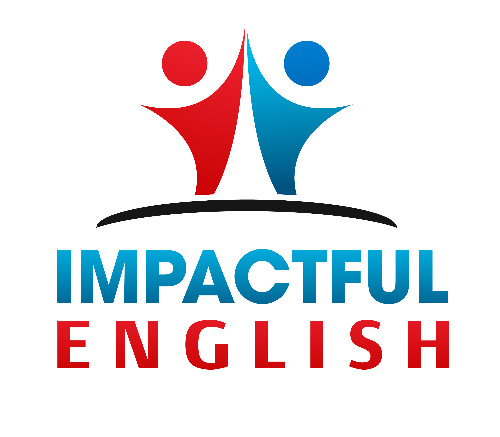

52 Phrases for Better Flowing English Presentations
/ Steven Hobson / Business English , English Presentations , Vocabulary

Do you give English presentations at work, but feel that you could communicate your message in a more objective, fluid way?
Maybe you have an English presentation coming up and want to make sure that your speech is clear and structured so that your audience doesn’t lose concentration and stays with you all the way to the end.
A technique that can help you achieve objective, clear, and structured English presentations, is to use linking phrases that join the separate parts of your presentation together.
English presentations normally consist of an introduction, the main body, individual parts of the main body, and the ending or conclusion.
To help maintain your audience’s attention, you need to signal when you are going from one part to another.
In this article, I teach you 52 phrases that do exactly this – linking the different parts together, and therefore, making your presentation flow better. You’ll find that these phrases will act as ‘signposts’ for the audience when you finish one part and start another.
52 Phrases to Improve the Flow of Your English Presentations
The introduction.
All good presentations start with a strong introduction.
There are a number of different ways you can begin your English presentation. Here’s a simple, but effective introduction structure which works for most types of business presentations:
Introduce – Introduce yourself and greet your audience. Introduce the presentation topic – Explain the reasons for listening. Outline – Describe the main parts of the presentation. Question policy – Make it clear to your audience when they can ask questions: during or at the end?
Here are some phrases which you can use to structure the introduction in this way:
1. Good morning/afternoon (everyone) (ladies and gentlemen). 2. It’s a pleasure to welcome (the President) here. 3. I’m … (the Director of …)
Introduce the presentation topic
4. By the end of the talk/presentation/session, you’ll know how to… / …you will have learned about… / 5. I plan to say a few words about… 6. I’m going to talk about… 7. The subject of my talk is…
8. My talk will be in (three parts). 9. In the first part… 10. Then in the second part… 11. Finally, I’ll go on to talk about…
Question Policy
12. Please interrupt if you have any questions. 13. After my talk, there will be time for a discussion and any questions.

Main Body
Now that you have finished the introduction, we now need to transition to the main body, and its individual parts in a smooth way.
There are three parts of the main body of a presentation where linking phrases can be used:
Beginning the Main Body Ending Parts within the Main Body Beginning a New Part
Here are some phrases which you can use for these parts:
Beginning the Main Body
14. Now let’s move to / turn to the first part of my talk which is about… 15. So, first… 16. To begin with…
Ending Parts within the Main Body
17. That completes/concludes… 18. That’s all (I want to say for now) on… 19. Ok, I’ve explained how…
Beginning a New Part
20. Let’s move to (the next part which is)… 21. So now we come to the next point, which is… 22. Now I want to describe… 23. Let’s turn to the next issue… 24. I’d now like to change direction and talk about…
Listing and Sequencing
If you need to talk about goals, challenges, and strategies in your English presentation, listing phrases can help link these together and improve the flow of your speech. If you have to explain processes, sequencing phrases are helpful:
25. There are three things to consider. First… Second… Third… 26. There are two kinds of… The first is… The second is… 27. We can see four advantages and two disadvantages. First, advantages… 28. One is… Another is… A third advantage is… Finally…
29. There are (four) different stages to the process. 30. First / then / next / after that / then (x) / after x there’s y. 31. There are two steps involved. The first step is… The second step is… 32. There are four stages to the project. 33. At the beginning, later, then, finally… 34. I’ll describe the development of the idea. First the background, then the present situation, and then the prospect for the future.
After you have presented the main body of your English presentation, you will want to end it smoothly.
Here are typical sections transitioning from the main body to the ending of the presentation, and then inviting the audience to ask questions:
Ending the Main Body Beginning the Summary and/or Conclusion Concluding An Ending Phrase Inviting Questions and/or Introducing Discussion Thanking the Audience
Ending the Main Body
35. Okay, that ends (the third part of) my talk. 36. That’s all I want to say for now on (the 2017 results).
Beginning the Summary and/or Conclusion
37. To sum up… 38. Ok, in brief, there are several advantages and disadvantages. 39. To conclude… 40. I’d like to end by emphasizing the main points. 41. I’d like to end with a summary of the main points.
42. I think we have seen that we should… 43. In my opinion, we should… 44. I recommend/suggest that we… 45. There are three reasons why I recommend this. First, … / Second, … / Finally,…
An Ending Phrase
46. Well, I’ve covered the points that I needed to present today. 47. That sums up (my description of the new model). 48. That concludes my talk for today.
Inviting Questions and/or Introducing Discussion
49. Now we have (half an hour) for questions and discussion. 50. So, now I’d be very interested to hear your comments.
Thanking the Audience
51. I’d like to thank you for listening to my presentation. 52. Thank you for listening / your attention. / Many thanks for coming.
Linking phrases are like the skeleton which holds your presentation together.
Not only do they improve the flow and help guide the audience, but by memorizing them they can also help you remember the general structure of your presentation, giving you increased confidence.
To help you memorize, I recommend saying the linking phrases on their own from the beginning to the end of your presentation while you practice.
I also suggest memorizing the introduction word for word. By doing this, you will get off to a great start, which will settle your nerves and transmit a positive first impression.

Whenever you’re ready, there are 3 ways I can help you:
1. The Impactful English Academy : Join like-minded professionals from around the world in The Impactful English Academy. The comprehensive online courses will teach you the system and strategies I have used to help 100’s of professionals speak English more fluently, confidently and professionally. Click here to learn more.
2. One-to -one Coaching : Get access to my guidance and a customised program that has helped, managers, directors, CEO’s, doctors and Government officials worldwide transform into confident and articulate communicators in English. Click here to book a Discovery session with me.
3. Onsite and Online Company Training: Equip your team with the essential communication skills they need to thrive in today’s global marketplace. My tailored onsite and online training programs empower professionals to communicate effectively and confidently in English in international business environments. C lick here to schedule a meeting with me.
Author: Steven Hobson
Steven is a business English coach, a certified life coach, writer, and entrepreneur. He helps international professionals build confidence and improve fluency speaking English in a business environment.
Related posts

A Proven Way to Negotiate More Confidently in English

You Don’t Need Perfect English to Speak with Confidence

4 Proven Actions to Speak Up More in English Meetings
- Facebook Profile
Learning English with Oxford
The latest language learning tips, resources, and content from oxford university press., useful phrases for giving a presentation in english.
- by Oxford University Press ELT
- Posted on April 21, 2023 February 2, 2024

Giving a presentation in English can be challenging, but with these helpful phrases, you can feel confident and ready to make a good presentation in English.
Starting your presentation
So how to start a presentation in English? Begin by saying hello and welcoming everyone. You can also thank the audience for being there with you.
The beginning of the presentation is one of the most important parts because you need to make sure your audience is interested from the start.
You could tell a short story, give a fact, or simply tell the audience a little bit about yourself, e.g. ‘ Let me start by telling you a little bit about myself …’
Then, introduce what your presentation is about by giving an opening statement or an overview of your session. For example, ‘Today, I am going to talk to you about …’ or, ‘Today, we’ll be looking at/focusing on …’.
You can also tell the audience, ‘ If you have any questions, please raise your hand and I’ll be happy to answer them’ … or ‘ We’ll have time at the end for questions.’
Presenting the topic
When you get into the main part of giving your presentation in English, remember that what you’re saying to your audience is new information. Speak slowly, organise your ideas, and make sure your pronunciation is clear. You can learn more about boosting your pronunciation here .
Use expressions to order your ideas and introduce new ones. You can use words and phrases to sequence like, firstly/first of all, secondly, then, next, following this, and lastly/finally.
If you want to introduce the opposite point of view, you can use language like however, on the other hand, contrary to this and then again.
It’s a good idea to link what you are saying back to previous things you have said. This shows you have a well-organised presentation and also helps keep people engaged. For example, ‘as I said previously/at the beginning …’, ‘as you may remember’ and ‘this relates to what I said about ….’
Highlighting information during your talk
When you are giving a presentation in English, you might want to highlight a particular piece of information or something that’s important. You can use phrases such as ‘Let’s focus on …’, ‘I want to highlight …’, ‘Pay attention to …’, ‘Let’s look at …’, ‘I want to briefly address …’, or ‘Now, let’s discuss ….’ You can use these phrases after your sequencing words to help you with your structure.
You can also highlight information by asking your audience their opinion of what you are saying or having them engage with the presentation in some way. For example, you could ask a question and have the audience raise their hands if they agree, or disagree, or if you want to find out how many of them have experience with the situation you’re discussing. Asking questions is a good way to make sure you still have the audience’s attention after you’ve been speaking for a while.
You can also highlight information on your visuals if you’re using them. Use bright, impactful pictures and colours, and don’t include too much writing on your slides.
Finalising the talk
At the end of the presentation, you should summarise your talk and remind the audience of the things you have discussed, and the new information you have given them. You can say things like ‘In summary, we have looked at …’, ‘I’d like to finish by …’, and ‘We’re coming to the end of the presentation. We’ve discussed …’.
You can then ask the audience for any questions you haven’t already answered.
What are your experiences of giving a presentation in English? Do you have any other tips to add? Share below!
Billie Jago is an ELT writer and teacher trainer, specialising in digital & assessments. She is the founder of the professional development podcast ELTcpd and co-founder of the digital ELT content agency, otterelt .
Share this:
Author: Oxford University Press ELT
Every year we help millions of people around the world to learn English. As a department of the University of Oxford, we further the University’s objective of excellence in education by publishing proven and tested language learning books, eBooks, learning materials, and educational technologies. View all posts by Oxford University Press ELT
before You start your presentation ,try please to mention the time duration . sometimes people should be informed so that we can take a coffe break or cigarettes break in order to make evry one happy with the topics
Here is the tip I would add according to my experience :
end your presentation on a positive note, for example with a funny sentence /image /meme / an inspirational quote, in short something that will make your talk pleasant to remember.
Valentina T.
You need to chill out and show calmness and confidence. You should rehearse your presentation on the stage some time before its previously stated time.
Clear, cogent & commanding. Thanks.
I think to get better respond to presentation you can do some mistakes in it and then explain it the end or in the next presentation. Because if anyone would like to learn something also should show involvement.
Leave a Reply Cancel reply
Discover more from learning english with oxford.
Subscribe now to keep reading and get access to the full archive.
Type your email…
Continue reading

60 Useful and Impactful Phrases for Presentations in English: A Quick Glimpse for Presenters
Introduction.
Are you up for a presentation in English but don’t know how to start yet? Preparing and making a persuasive presentation in English is quite challenging and taxing. You have to consider a lot of things before you can finalize it. A good presentation relies heavily on the words or phrases you use to clearly convey your message to your target audience.
Then, what kind of phrases for presentations in English should you use to persuade your audience and get them involved in your presentation?
In this article, we are going to talk about useful and impactful phrases for presentations in English that you can effectively use in your future presentations. Before that, let us discuss first the importance of these phrases in English presentations.
The Importance of Having Impactful Phrases for Presentations in English
In the business world, presentations play a significant role because they make reports easier to convey and understand. Presentations delivered in English are impactful and are often commended. Thus, having impactful phrases for presentations in English is an additional advantage to get your audience’s attention and be on track.
Say for example you are assigned to lead a new project and you are tasked to give a progress report to your boss. It would not be nice to give him just verbal updates about the progress of the project you handle. It would be better to show him the things that have been working well so far, and things that have been a worry. With just a verbal report, your boss might not be able to understand clearly.
With that, using a presentation is important for him to clearly visualize what is going on with the project. Presentations also give you the chance to be constructively corrected. It also serves as a formal report.
Using impactful phrases for presentations in English leaves a lasting impression on your audience. These phrases can greatly enhance the effectiveness of your report. The more you use persuading phrases or expressions in your presentations, the greater the chance you have to be recognized.
Do you want to be recognized and commended? This article is for you, so keep reading and we’re with you all throughout.
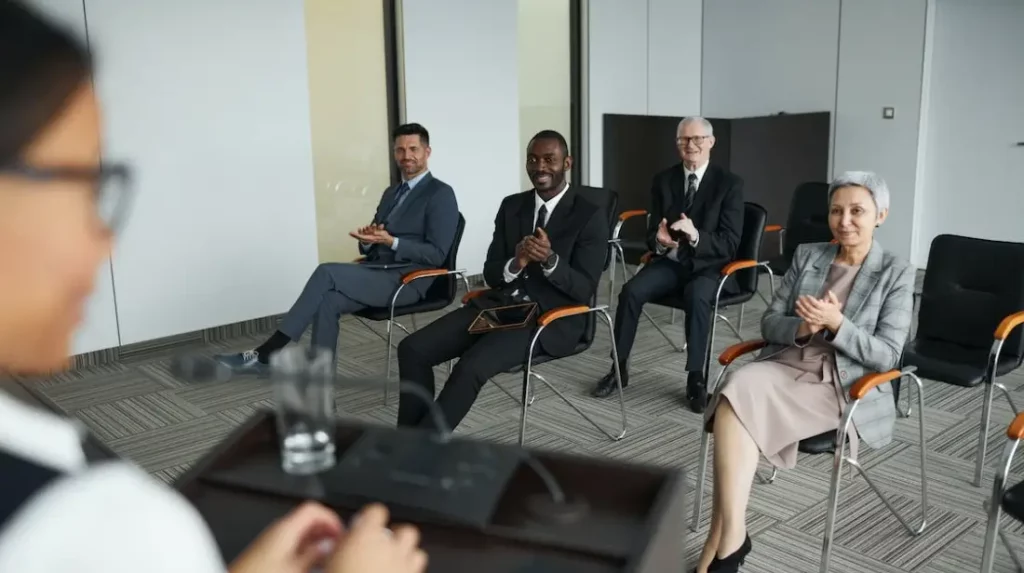
Useful and Impactful Phrases for Presentations in English
Aim for a long-lasting impression on your audience by using the following useful and impactful phrases in your next presentation in English.
- Setting a bright atmosphere
At the beginning of the presentation, you would want your audience to interact with you throughout so setting a warm and bright atmosphere before it is crucial. You can use the following expressions:
- “Good day, everyone! Who’s up for a game?”
- “It’s nice to see everyone with a smile today.”
- “I am glad you all came to attend this meeting.”
- “Before we start, let’s have an icebreaker first to keep everyone going!”
- “Have you ever…?”
Remember to get your audience engaged right at the beginning of your presentation.
- Setting your audience’s expectations
In some presentations, the audience expects more of what you can give, so it is good to give them a brief overview of what the presentation is about and what will happen.
- “This presentation will last about 30 minutes.”
- “All questions and concerns will be attended to after the presentation.”
- “We will allocate spare time for your questions and concerns.”
- “The first part of the presentation would be…”
- “There will be more slides in the presentation so please bear with me.”
- “This presentation will take longer than usual.”
- “If you have questions during the presentation, please write them on these pieces of paper so we can answer them later.”
- “Please take down notes for your reference.”
- “Handouts will be distributed to everyone.”
- “There will be more games and interaction in this presentation.”
- Starting your presentation
It is always nice to warmly welcome your audience before going deeply into your topic.
- “I would like to formally welcome everyone today.”
- “Please sit comfortably and relax.”
- “Let’s start this presentation by introducing myself. My name is _________.”
- “My name is ______ and I am from _______ department.”
- “I’d like to share a quote from …”
- “I have an anecdote to share and I’d love everyone to listen.”
- “What do you think about the quote shared by…?”
Sometimes, it is better to start your presentation with an anecdote or a quote related to your presentation.
- Introducing your topic
You may use the following phrases for presentations in English when introducing your topic.
- “Today, I will be talking about…”
- “The topic of my presentation today is about …”
- “My presentation is relevant to…”
- “I am glad to present to you the progress of …”
- “As you can see, I am here to report about…”
- “There are three major topics that I’m going to discuss today.”
- Discussing the content of your topic: showing images, graphs, and illustrations
When discussing the content of your presentation, it is good to use the following expressions.
- “As you can see in the graph…”
- “Here is an example illustration of…”
- “Look at the graphic on the screen.”
- “This illustration/graph shows the result of…”
- “Things don’t look good in this image so…”
- “I visualize this project as…”
- “You can see the graph showing the trends…”
- Engaging your audience
It’s okay to pause for a while and get your audience involved in your presentation.
- “What do you think about it?”
- “Do you have any additional insights?”
- “Please feel free to share your thoughts about it.”
- “Your opinion really matters.”
- “Kindly let me know if you have questions or clarifications.”
- “I’d love to hear your thoughts about this.”
- “Who would like to share their personal thoughts on this?”
- Emphasizing or highlighting important information
- “This is very important because…”
- “The good thing about this one is that…”
- “Our key takeaway for this matter is…”
- “The most important thing in this project is the…”
- “The decrease will not affect our sales target…”
- Entertaining questions and concerns
Some members of the audience inevitably ask you questions about your presentation so it is best to be prepared. If not, might as well be polite instead.
- “Thank you for your question, Mr./Ms. _____.”
- “That’s a very good question.”
- “Thank you for raising that concern.”
- “I’d love to answer your question, but let me finish this first.”
- “I will attend to all your questions after the presentation.”
- Ending your presentation and leaving a long-lasting impression
You may not impress all in the audience with your presentation but you must know how well you delivered your presentation. End it with a bang, and leave a lasting impression on your audience.
- “This is not easy, but I know we can do this.”
- “Thank you so much for sparing your precious time on this presentation.”
- “I really appreciate your presence in this meeting.”
- “We are all in this together, so let’s start making a difference.”
- “I’d like to commend our workers for…”
- “Good job to everyone for a job well done.”
- “Kudos! Let’s continue to be productive and excellent.”
- “You’re all amazing.”
You can also end your presentation with a quote or a personal anecdote for your audience to remember you.
These phrases for presentations in English are helpful ways to make your presentation easy to understand as well as impactful. These are just examples of phrases you can use when presenting in English. You can always experiment and create sounding phrases to persuade your audience.
By knowing these phrases, you enhance the effectiveness of your delivery as well as your communication skills. This is your way to overcome your fear of speaking English . Most importantly, the impression you will leave to your listeners will last for a long time.

What to consider when preparing a presentation?
Presentations can be simple depending on your target audience, the context, and the time frame. These are just a few of the things you have to consider when preparing a presentation. You can also ask yourself the following questions.
- Know your target audience. Who are the attendees? Your presentation must be appropriate for the listeners.
- Where is the presentation? Check the situation.
- How long will the meeting last? How much time is allocated for your presentation?
- What data should you present? Think about the most important highlight in your topic.
- Should you use a PowerPoint presentation? This is better than just speaking without material.
- Are games or activities suitable for the presentation? If not, never mind. You’ll just waste your time.
- What interactive activities should you include? This is nice to get your audience engaged.
- What if you cannot answer the questions? Anticipate and prepare a backup answer.
Presentations are always easy when you know how to consider things during your preparation. Things do not always go easy, especially when it is your first time. However, just be confident and relax. Your goal is to deliver a good and effective presentation, but most of all, to impress your audience.
Get ready for your next presentation…
You have just learned some useful and impactful phrases for presentations in English. Now you are ready for your next presentation. Focus and think about your primary goal: the impression.
- March 12, 2024
Leave a Comment Cancel Reply
Your email address will not be published. Required fields are marked *
Save my name, email, and website in this browser for the next time I comment.
You may enjoy these articles

Skyrise 4, 7th Floor, Cebu City, 6000, Cebu
+63 32 479 9047

Start typing and press enter to search
Vocabulary and Phrases for Making Presentations in English
Here’s a step-by-step guide for making presentations in English. You’ll find the phrases you need for each step of your presentation.
After you give your opening statement, give a brief overview of your presentation. Say what your presentation is about, how long you will take and how you are going to handle questions.
For example, a presentation to sales staff could start like this: “Welcome / “Hello everyone.”
(Opening statement) “As you all know, this company is losing its market share. But we are being asked to increase sales by 20 – 25%. How can we possibly increase sales in a shrinking market?”
(Overview) “Today I am going to talk to you about how we can do this. My presentation will be in three parts. Firstly I am going to look at the market and the background. Then I am going to talk to you about our new products and how they fit in. Finally, I’m going to examine some selling strategies that will help us increase our sales by 20%. The presentation will probably take around 20 minutes. There will be time for questions at the end of my talk.”
Useful language for overviews
“My presentation is in three parts.” “My presentation is divided into three main sections.” “Firstly, secondly, thirdly, finally…” “I’m going to… take a look at… talk about… examine… tell you something about the background… give you some facts and figures… fill you in on the history of… concentrate on… limit myself to the question of…
“Please feel free to interrupt me if you have questions.” “There will be time for questions at the end of the presentation.” “I’d be grateful if you could ask your questions after the presentation.”
The main body of the presentation
During your presentation, it’s a good idea to occasionally remind your audience why your presentation and ideas are important or relevant.
“As I said at the beginning…” “This, of course, will help you (to achieve the 20% increase).” “As you remember, we are concerned with…” “This ties in with my original statement…” “This relates directly to the question I put to you before…”
Keeping your audience with you
Remember that what you are saying is new to your audience. You are clear about the structure of your talk, but let your audience know when you are moving on to a new point. You can do this by saying something like “right”, or “OK”. You can also use some of the following expressions:
“I’d now like to move on to…” “I’d like to turn to…” “That’s all I have to say about…” “Now I’d like to look at…” “This leads me to my next point…”
If you are using index cards, putting the link on the cards will help you remember to keep the audience with you. In addition, by glancing at your index cards you will be pausing – this will also help your audience to realise that you are moving on to something new.
Phrases for introducing visuals
It’s important to introduce your visual to the audience. You can use the following phrases:
“This graph shows you…” “Take a look at this…” “If you look at this, you will see…” “I’d like you to look at this…” “This chart illustrates the figures…” “This graph gives you a break down of…”
Give your audience enough time to absorb the information on the visual. Pause to allow them to look at the information and then explain why the visual is important:
“As you can see…” “This clearly shows …” “From this, we can understand how / why…” “This area of the chart is interesting…”
Summarising
At the end of your presentation, you should summarise your talk and remind the audience of what you have told them:
“That brings me to the end of my presentation. I’ve talked about…” “Well, that’s about it for now. We’ve covered…” “So, that was our marketing strategy. In brief, we…” “To summarise, I…”
Relate the end of your presentation to your opening statement:
“So I hope that you’re a little clearer on how we can achieve sales growth of 20%.” “To return to the original question, we can achieve…” “So just to round the talk off, I want to go back to the beginning when I asked you…” “I hope that my presentation today will help you with what I said at the beginning…”
Handling questions
Thank the audience for their attention and invite questions.
“Thank you for listening – and now if there are any questions, I would be pleased to answer them.” “That brings me to the end of my presentation. Thank you for your attention. I’d be glad to answer any questions you might have.”
It’s useful to re-word the question, as you can check that you have understood the question and you can give yourself some time to think of an answer. By asking the question again you also make sure that other people in the audience understand the question.
“Thank you. So you would like further clarification on our strategy?” “That’s an interesting question. How are we going to get voluntary redundancy?” “Thank you for asking. What is our plan for next year?”
After you have answered your question, check that the person who asked you is happy with the answer.
“Does this answer your question?” “Do you follow what I am saying?” “I hope this explains the situation for you.” “I hope this was what you wanted to hear!”
If you don’t know the answer to a question, say you don’t know. It’s better to admit to not knowing something than to guess and maybe get it wrong. You can say something like:
“That’s an interesting question. I don’t actually know off the top of my head, but I’ll try to get back to you later with an answer.” “I’m afraid I’m unable to answer that at the moment. Perhaps I can get back to you later.” “Good question. I really don’t know! What do you think?” “That’s a very good question. However, we don’t have any figures on that, so I can’t give you an accurate answer.” “Unfortunately, I’m not the best person to answer that.”
What to say if things go wrong during your presentation
You think you’ve lost your audience? Rephrase what you have said:
“Let me just say that in another way.” “Perhaps I can rephrase that.” “Put another way, this means…” “What I mean to say is…”
Can’t remember the word?
If it’s a difficult word for you – one that you often forget, or one that you have difficulty pronouncing – you should write it on your index card. Pause briefly, look down at your index card and say the word.
Using your voice when making presentations
Don’t speak in a flat monotone – this will bore your audience. By varying your speed and tone, you will be able to keep your audience’s attention. Practise emphasising key words and pause in the right places – usually in between ideas in a sentence. For example “The first strategy involves getting to know our market (pause) and finding out what they want. (pause) Customer surveys (pause) as well as staff training (pause) will help us do this.”
Don’t forget – if you speak too fast you will lose your audience!
Making Presentations
Your answer:
Correct answer:
Your Answers

Live-English.net
Learn English Online with real teachers
30 Useful Sentences for a Presentation in English
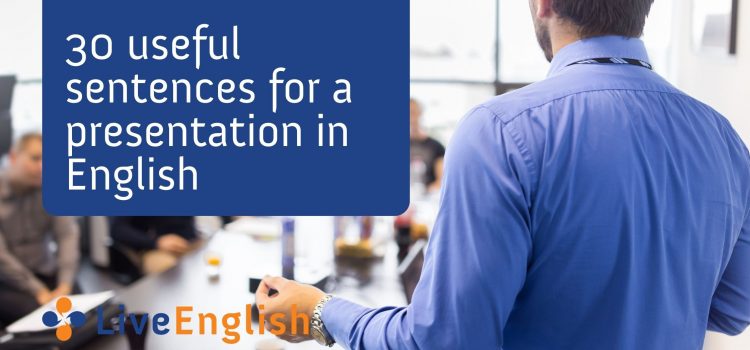
Following our successful post about 30 Useful Sentences for a Job Interview in English , we’re now reviewing the vocabulary and expressions you need if you’re giving a presentation in English.
If talking in front of a crowd, big or small, can be nerve-racking, having some useful sentences up your sleeves will help you stay focused.
It doesn’t matter if the presentation is on Zoom or in front of a live audience, preparing yourself for it is crucial.
So let’s get started!
Starting the presentation in English and welcoming the crowd
There are different ways to start a presentation in English. These sentences are very classic ways to welcome your audience.
1. Good morning/afternoon/evening
2. Welcome to [name of company/presentation/place]
3. What I’m going to talk about today is …
4. Today I’m going to discuss…
5. The topic of my presentation today is …
6. The aim of this presentation is…
7. My presentation today is about…
8. Today I’d like to talk about…
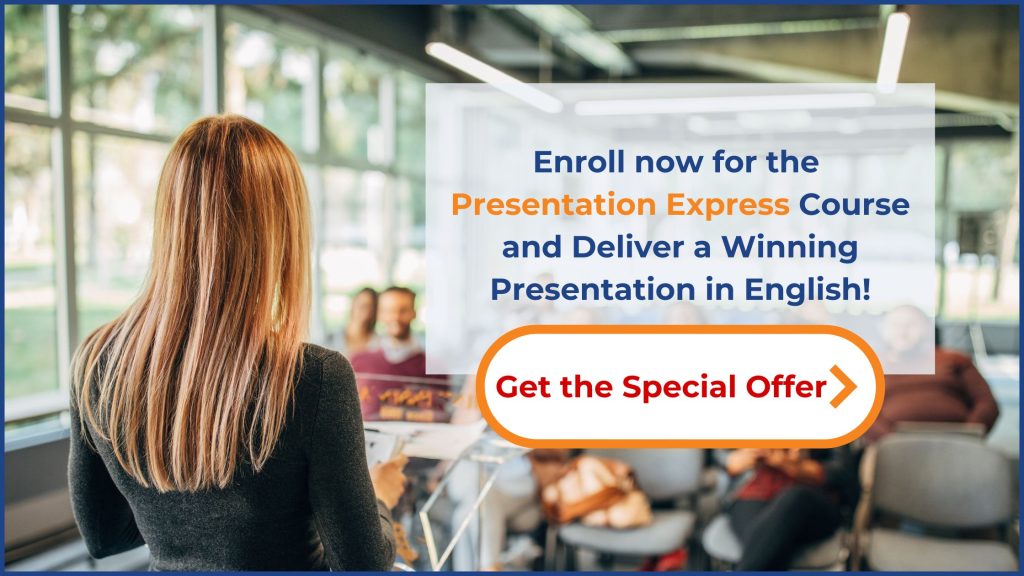
Introducing yourself in a presentation in English
You want to take advantage of your presentation in English to tell the audience about who you are and what you do.
9. My name is [name] and I am from [company], where I’m responsible for …
10. I’m [name]. I’m a [job position] at [company].
11. Let me introduce myself; I’m [name] and I work at [company], where I work in [name of the department].
Presenting the topic
Now we are getting to the real start of the presentation. You want to be clear on what you’re going to present and the goal of your presentation.
12. Today, I’ll be talking about/discussing [topic]
13. I’m here to illustrate how…
14. What I’m going to be talking about today is…
15. The purpose of today’s presentation is…
16. My objective is to…
17. In today’s presentation, I’d like to talk to you about/show you/demonstrate…
Outlining the content of the presentation
It is important to clarify the different steps you’re going to follow in your presentation.
18. In today’s presentation I’m going to cover [three] points:
19. Firstly, I’ll be looking at…
20. Secondly, we’ll consider…
21. Then, I’ll explain how…
22. And finally, I’ll demonstrate how …
23. My talk will be in [two, three, four] parts: First,…after that,… then,… finally,…
24. Firstly,… Secondly,… Thirdly,… Finally,…
25. I’ll begin by looking at… Then, I’ll move on to…Towards the end I …
Introducing the first point
Signposting is very important to make sure your audience understands the logic of your presentation in English and follows the different steps you draw.
26. So let’s start, shall we?
27. To begin with, …
28. To start with, …
29. First of all, I’ll …
30. Let’s start by [+ verb in -ing form] …
To go further with your presentation in English
There are many more expressions you need for a presentation in English: – explaining graphs, images, or data. – Concluding a point – Moving on to the next point – Focusing your audience’s attention – Referring backward/forwards – Concluding and summarising the presentation – Inviting questions – Dealing with questions
This is outside of our current scope for this blog post but definitely something to keep in mind for a successful work presentation in English.

You are not alone to prepare for your presentation in English
Do you need help with a presentation in English? We have a few options for you.
If you have to give a presentation in English in the coming days or weeks, rehearse with a private English teacher. They will help you fine-tune your presentation, your slides, the way you introduce the topic, and help you deal with things you can’t really prepare like questions from the audience. This is part of our Premium Courses .
If you don’t have a specific presentation to give but would like to get the skills and practice to be a better communicator, check out our Presenting in English workshop .
- ← How to improve your business English vocabulary
- 30 key phrases to use in a meeting in English →
You May Also Like

Top 15 English terms in IT

Business English: Marketing Vocabulary You Need To Know

The 8 Reasons Students Love our Business English Ebook
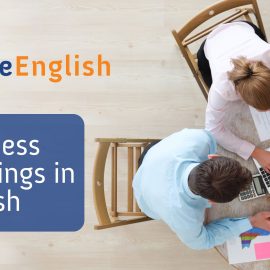
How to Handle Business Meetings in English if English is Not Your Mother Tongue

How to improve your business English vocabulary

Top Five Mistakes to avoid while writing an email in English
Privacy Overview
You are using an outdated browser. Please upgrade your browser or activate Google Chrome Frame to improve your experience.
35 Powerful Presentation Phrases in English for Engaging Your Audience

Your palms are sweating.
For a moment, your mind goes blank.
All eyes are on you.
That moment right before you start presenting – as you take in your audience – is usually the scariest. The nervousness lessens with practice, but even the most frequent public speakers still get butterflies in their stomach sometimes. Whether you’re facing an entire room of people or looking at everyone through your laptop screen, giving a presentation can still be intimidating – or exciting, once you move beyond the fear.
There’s an extra layer of challenge too if you have to speak in your non-native language. For a more professional-sounding and engaging presentation, we’ve compiled some of the most useful English presentation phrases below.
We’ll also explore what else you can do to make even more of an impact on your audience. With the right intonation, body language, and gestures, you’ll really be able to catch their attention and emphasize your points.
Delivering a Powerful Presentation
To lay the groundwork for your presentation in English, here’s what you’ll have to do first:
Consider the audience
You’re probably always going to need slides, but every presentation will be different – and the audience that you’ll be presenting to won’t always find the same points interesting. Because of this, you’ll have to tailor your message to them. What style of presentation would be a good fit? For example, some audiences would want to see a lot of number-crunching, while others might be looking for more personal storytelling .
Prepare a structure
Structure is key in presentations. People have short attention spans, and they can be forgetful. At the end of the day, your goal is for them to remember at least the main points in your presentation. What message do you want to convey? Since you might be discussing a lot of information, you can make it more digestible by ensuring that there’s a logical progression and then ending with a summary.
Key Business Phrases
Once you’ve decided on the style and message of your presentation, you can take it up a notch by including certain English presentation phrases all throughout. Let’s break it down from start to finish:
Introduction
This is when you’ll be warming up your audience before you proceed to your main points.
Greeting the audience
If you’re presenting to people who aren’t too familiar with you, you can quickly introduce yourself and mention your role or company.
- Good morning, everyone. I’m glad to be able to present to all of you.
- Hello, everyone! It’s nice to see all of you today. I’m [name], the [position] from [company].
Describing your topic
After greeting the audience, you’ll be explaining to them what your presentation is all about. To set their expectations, you might show them an outline of the talk and mention if there’ll be any activities such as breakout discussions.
- I’ll be talking about…
- I’ll be talking about our financial metrics over the past year.
- The topic of this presentation will be…
- The topic of this presentation will be major trends in the logistics industry.
- I’ll be discussing first the [first topic], next [second topic], and finally [third topic].
- I’ll be discussing first the project’s ideation process, next our initial trial, and finally, presenting our results.
Addressing questions and technical concerns
People might be wondering if they can ask questions during your presentation, so you can clarify this at the start. If you’re providing handouts or presenting online, it’s useful to ask people to alert you about any technical concerns.
- Please feel free to ask any questions during the talk.
- For questions, there will be a Q&A section at the end.
- Can all of you see and hear me properly? Please let me know if you have any technical difficulties during the presentation.
The body will make up the bulk of your presentation. Ideally, you would go through each of your points logically while letting your audience know when you’re moving on to the next section.
The longer your presentation, the more important it is to use sequencing phrases. These act as cues that let your audience know where you are in the presentation. You can think of these as similar to detour signals that make the audience much more likely to get your meaning.
- First, let’s discuss the…
- First, let’s discuss the initial spark for this idea.
- Moving into [the next item / point] …
- Moving into item 4, we can see that this is a major pain point for our target market.
- This leads us to the next…
- This leads us to the next section, where we’ll be looking at the facts and figures.
Linking is closely related to sequencing. Similar to writing, you can have a smoother presentation by connecting your ideas rather than suddenly jumping from one point to another. You can also refer back to points that you’ve mentioned before to make your presentation more cohesive.
- In connection to what I said earlier…
- In connection to what I said earlier about growing our online presence, we can now look into potential social media campaigns.
- What this means is…
- What this means is that most of our growth is coming from a certain sector. Let’s analyze the data for this in the next section.
- This ties in with…
- This ties in with our survey findings about user reactions. I’ll go into detail about changes we’ve made to the app as a result.
Giving examples
To fully convey your point, you can bring up specific examples and case studies. These are much more memorable as well as engaging because you can tell these in the form of a story.
- For example…
- For example, costs were reduced significantly when we switched to the following materials.
- To demonstrate this point…
- To demonstrate this point, I’ll be showing you a video of a business that used this problem-solving method.
- Here’s an example of…
- Here’s an example of a seasonal product that our customers loved.
Showing visuals
Visuals naturally attract people’s attention. If you’re using slides for your presentation, take the opportunity to include images, diagrams, infographics, or even charts.
- As you can see from this…
- As you can see from this photo, we’ve redesigned our office space.
- Here’s a diagram / picture / chart that shows…
- Here’s a diagram that shows a high percentage of people are comfortable with online shopping.
- If you look at this…
- If you look at this infographic, you can see that the new color palette comes off as fun and casual.
Citing data
Citing data from research makes your presentation more persuasive. When you’re talking about results that you’ve achieved, try to bring up actual numbers – this can go a long way towards impressing your audience.
- According to this study…
- According to this study from [journal], 65% of eCommerce companies are looking for more efficient payment methods.
- Based on our research…
- Based on our research, the most enthusiastic buyers of wellness products in this city are in the 20 to 30 age range.
- Looking at the data…
- Looking at the data, you’ll notice that there’s been an 18% spike in sales since we migrated our platform.
Restating an idea
Sometimes you’ll want to restate an idea so it’s easier to understand. This also serves to emphasize it. Because of the repetition, people are more likely to remember it compared to if you’d only mentioned it once.
- In other words…
- In other words, partnering up with this client can make our operations more efficient and seamless.
- Another way of saying this is…
- Another way of saying this is that there might actually be more demand than supply by next year.
- What I mean is…
- What I mean is we’re already more than halfway to our business objective.
Handling technical issues
When you’re presenting on video call, all kinds of glitches can happen. Someone might have connection issues, you might have to figure out an app feature you’ve never used before, or background noises might keep interrupting your call. The phrases below can be very handy in these kinds of situations.
- If you can’t hear me, can you type in the chat, please?
- Could everyone mute their mic? There’s a lot of background noise.
- Sorry. The call dropped. I’m back through.
Concluding the Presentation
By this time, the hardest part is already over! Still, you’ll have to wrap up your presentation nicely by going over the key takeaways during the conclusion. Your audience might also have questions that they’ll want you to address.
Summarizing the presentation
Out of everything that you’ve discussed, what would you like people to get out of it? A short summary towards the end serves to highlight your main ideas.
- To wrap up…
- To wrap up, I’d like to point out three major takeaways.
- As a summary…
- As a summary of this report update, I would say we have seen a positive uptick in our workflow and productivity.
- All in all…
- All in all, we believe we’ve seen good results for this stage of our progress.
Thanking the audience
Similar to your greeting at the start, it’s common to address your audience again towards the end by thanking them for their time.
- Thank you for listening!
- Thank you to everyone for being here.
- I’d like to thank you all for coming here.
Addressing questions
If you’re open to questions from your audience, you can have a short question-and-answer session after your presentation.
- Do you have any questions or clarifications?
- Feel free to ask me about any of the points I made during the presentation.
- Let me know if you have any questions.
Practice is Crucial
When you’re all set with the content of your presentation, the next step is to practice your delivery. Regardless of how well you know the topic of your presentation, practicing it at least once will help you be more confident. You’ll discover potential issues that you can fix too before you go live.
Do a run-through
The most basic way to practice is to do a run-through of your entire presentation . Set a timer on your phone, open up your slides, then start talking – all while imagining that you’re already presenting to your audience. Since you’re acting as if it’s in real-time, this means avoiding any pauses where you have to look up information.
A run-through can pinpoint any weaknesses in your presentation, and you’ll notice any parts where you might be uncomfortable talking. You’ll also be able to see how much time you’ve spent so you can pace yourself accordingly.
Record yourself
A more intensive version of the run-through basic would be to record yourself presenting. You can either record your voice or take a full video of yourself. People often notice that they use filler words a lot such as “um” or “uh.” You’ll also be able to check your pronunciation and whether you sound confident and natural all throughout.
Since body language can make or break your delivery, watching a video of yourself presenting is an incredibly effective way to improve your performance. Do your facial expressions match what you’re saying? Are you maintaining good posture throughout and making efforts to connect with the audience?
Presenting on Video Call
Technical issues happen often enough in face-to-face presentations, but they’re even more frequent during video calls. To avoid any awkward delays when you’re presenting, get comfortable with the platform that you’ll be using.
If it’s a face-to-face presentation, double-check your slides and make sure any images or videos are showing properly. For video calls, try doing a test call on the app or even call up a friend to practice. You can also get familiar with the app’s basic features, such as screen-sharing or inviting people to breakout rooms.
Let’s explore some of the most common glitches (and how you can deal with them gracefully!):
Situation 1: You’re having a hard time hearing other people because of their laggy connection.
For a presentation to work, everyone needs to have a decent internet connection. If someone’s connection drops, they won’t be able to see or hear you properly, and you won’t understand what they’re trying to say, either. In this case, let them know right away that you can’t hear them. You can also ask them to talk to you over chat instead.
Example Phrases:
- [Name], you’re cutting in and out. Would you mind reconnecting?
- Audio problems – can you type it on chat instead?
Situation 2: You get disconnected from the call.
In the case that it’s your connection that’s faulty, you might have to disconnect then reconnect your call. This can be awkward because it interrupts the flow of your presentation. Alerting your audience using certain English phrases can reassure them while getting you back on track with what you were saying.
- Sorry, guys, dropped call. But I’m back.
- Connection problems, everyone. Gonna log out and back in.
Situation 3: People are having a hard time figuring out how to turn on their audio or video.
Another reason why you’d want to be really familiar with the video platform is you might have to coach people when they experience glitches. It’s almost expected that a few people might accidentally forget to turn on their mic while speaking. Alternatively, they might have issues with turning on their camera.
- I can’t see you, [name]. [Give instructions on how to turn on their video.]
- I can’t see you, Fatima. Look for the camera icon and make sure there’s no red line through it.
- Typing in chat: “Make sure your mic’s unmuted.” [Clarify how they’ll know if they’re unmuted.]
- Typing in chat: “ Make sure your mic’s unmuted. There should be no red lines through it.
The best presentations excel in all three areas: content, structure, and delivery.
Including some of the key English phrases above will upgrade your performance. Aside from setting a professional tone, these English presentation phrases set the pace for your audience so they’re aware of where you are in the discussion. Your message will sound clearer, and your audience will be able to follow your ideas better.
The basic rules for presentations are the same, whether you’re on a video call or stepping in front of a stage. With the tips above, you’re all set to prepare an amazing presentation in English.
Related posts:

11 Essential English Gestures You Should Know to Advance Your Career

The Ultimate Guide to Mastering Greetings and Small Talk in English
Reply to this review cancel.
Thanks for choosing to leave a comment. Please keep in mind that all comments are moderated according to our comment policy , and your email address will NOT be published. Please Do NOT use keywords in the name field. Let's have a personal and meaningful conversation.
Recent Articles

The 30 Best Intermediate English Courses for B1, B2 and Beyond

The 1028 Most Common Words in English

Restaurant Conversations: 7 Scenarios When You Eat in an English-Speaking Place
Enter your e-mail address to get your free pdf.
We hate SPAM and promise to keep your email address safe

Business English
- How to answer the telephone in English
- How to give a company tour in English
- Giving presentations
- Pronunciation of technical vocabulary
- Planning your presentation
- Presentation software
- Phrases for presentations
- English grammar and vocabulary
- English grammar exercises
- B2 level materials
- Listen and read - stories
- Listen and read - grammar
- Practising English podcasts
- Games and activities
- Follow Practising English on Facebook...
Give a presentation in English: introduction
Tips and useful phrases.

Giving a presentation: the most challenging language skill
In this introduction into how to give a presentation in English I'll ask how a student of English can speak and be convincing in front of an audience. Or when speaking in a teleconference with English as the common language. When considering the English language skills required in the workplace today, the ability to give a presentation or handle yourself in English in teleconferences among your colleagues and foreign counterparts is probably one of the most important. Furthermore, this skill is also the most challenging for the non-native speaker. Giving a formal presentation means you must stand up in front of an audience, try to sell your ideas, be convincing, diplomatic, concise, knowledgeable, and all this in a foreign language!
The presentation should be given by the person who knows the subject
Despite the challenges involved, more and more of my business English students are now called upon by their companies to give a presentation in English although their language level may be below an intermediate level. Presentations should be given by specialists in their particular field of work and not by those employees who simply have the best level of English.
Giving a presentation without advanced English
This means that a company with international connections may have to choose someone to talk about his or her area of work even though their English language level is not proficient. However, it is possible to give presentations without having advanced English if you plan correctly, take time to practise pronunciation and key English phrases and rehearse your talk beforehand. One thing to remember is that there is an advantage to this situation. You can plan what you say before you speak - something we cannot do when in a conversation, for example. This means that like an actor in a film taking on a role of a foreign character, you can learn what you want to say before you speak and, if we are careful not to ask the audience not to interrupt, we can give a passable or even an excellent presentation. Furthermore, the intensive language learning that will take place while you are studying the expressions you will need for your presentation will provide you with a boost to your language skills s you learn how to talk about yourself as a professional, your company and its products and services.
I believe the development of presentation skills in English may be the initial step to take linguistically. Once we are able to express ourselves proficiently in this medium, we will then find we are better qualified to take part in more demanding language tasks such as the teleconference, where interaction and listening skills are also required. The following pages offer you, the business English student and company professional, advice and practical help to best prepare your presentation in English.
Good luck and most of all enjoy giving your presentations in English!
Part 1 - Pronunciation of technical vocabulary
Copyright © 2023 Practising English All rights reserved

IMAGES
VIDEO
COMMENTS
Effective - successful in producing a desired or intended result. Springboard - springboard is also something that provides an opportunity to achieve something. Handout - a document given to students or reporters that contains information about a particular subject. Q&A - an abbreviation for 'question and answer'.
Here are some phrases which you can use to structure the introduction in this way: Introduce. 1. Good morning/afternoon (everyone) (ladies and gentlemen). 2. It's a pleasure to welcome (the President) here. 3. I'm … (the Director of …) Introduce the presentation topic.
Highlighting information during your talk. When you are giving a presentation in English, you might want to highlight a particular piece of information or something that's important. You can use phrases such as 'Let's focus on …', 'I want to highlight …', 'Pay attention to …', 'Let's look at …', 'I want to ...
You may use the following phrases for presentations in English when introducing your topic. "Today, I will be talking about…". "The topic of my presentation today is about …". "My presentation is relevant to…". "I am glad to present to you the progress of …". "As you can see, I am here to report about…". "There ...
You can use the following phrases: "This graph shows you…". "Take a look at this…". "If you look at this, you will see…". "I'd like you to look at this…". "This chart illustrates the figures…". "This graph gives you a break down of…". Give your audience enough time to absorb the information on the visual.
There are different ways to start a presentation in English. These sentences are very classic ways to welcome your audience. 1. Good morning/afternoon/evening. 2. Welcome to [name of company/presentation/place] 3. What I'm going to talk about today is …. 4.
The general structure of a presentation is the following: It is up to you to design these three parts. Using videos or everyday-examples can be a great way to introduce the audience to the topic. The important thing is that you capture the audience's attention from the beginning by making an interesting introduction.
35 Powerful Presentation Phrases in English for Engaging Your Audience. Ima Ocon Date Published: 8 Jun 2021 Date Modified: 27 Sep 2024. Your palms are sweating. For a moment, your mind goes blank. All eyes are on you. That moment right before you start presenting - as you take in your audience - is usually the scariest.
The English phrases listed below are organised according to the following basic steps and will help you structure your presentation. Good morning, everyone. Hi! It's great to see so many familiar faces here today. Welcome to the audience Hello everyone, welcome to … Let me introduce myself. My name is … For those of you who don't know me,
However, it is possible to give presentations without having advanced English if you plan correctly, take time to practise pronunciation and key English phrases and rehearse your talk beforehand. One thing to remember is that there is an advantage to this situation. You can plan what you say before you speak - something we cannot do when in a ...